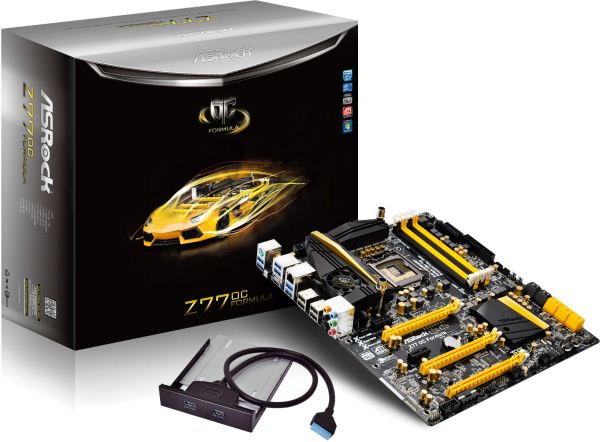ASRock Z77 OC Formula Review: Living In The Fast Lane
by Ian Cutress on January 15, 2013 1:00 PM EST- Posted in
- Motherboards
- ASRock
- Z77
- Overclocking
Final Words
When the Z77 OC Formula was first shown to the public at Computex 2012 (we covered it here), there was a small outcry on the basis of its name more than anything else. We already had the Gigabyte X58A-OC and ASUS Formula boards, so there was a large inkling that ASRock wanted a piece of this pie in their ‘OC Formula’ naming. When quizzed on this, ASRock pulled out the obvious analogy I was expecting:
“The name is derived from Formula 1 racing – the series will focus on overclocking which is like driving the race car.”
This mentality is clearly shown on the motherboard box, which features a Lamborghini Aventador mash-up with technology and going full bore on the yellow and black coloring scheme.
Naming aside, this is a board I really like to use. On the board itself We get integrated water cooling on the large VRM heatsink (like the ASUS Maximus V Formula), a liberal abuse of eight fan headers, 10 SATA ports (six SATA 6 Gbps), 8 USB 3.0 ports with 10 USB 2.0 ports for good measure, an ideal layout for dual-GPU setups, all the debug tools needed should anything go wrong, 13 (thirteen) onboard temperature sensors and even voltage read points for overclockers. Features not readily apparent include a multiple filter cap system to reduce electrical noise, and switches to enable/disable PCIe slots (reduce instability when not in use).
In my frequent BIOS rants, I often complain about interactivity, simplicity and experience, given that no motherboard manufacturer can offer me all three. ASRock’s BIOS continues to grow on me, and the Z77 OC Formula BIOS is almost great. Visually everything is easy to read, at a nice resolution, and every option gets a description of what it is and how to use it. The important options for overclocking are well laid out, and ASRock provide 12 automatic OC options for users to try. ASRock also likes to include their ever growing BIOS features like Internet Flash, OMG and Dehumidifier.
ASRock’s software package also gets a small overhaul – AXTU becomes ‘Formula Drive’, and operates in much the same way except for an upgraded fan tuning utility (compared to ASRock’s previous version, this one is awesome) and other menus relating to new functionality. We also get a memory timing configuration utility, and software to use the RapidOC buttons onboard. This is all on top of the XFast LAN, XFast USB and XFast RAM utilities. In the box are a set of plastic standoffs for the motherboard, making extreme overclocking without a test bench very easy, and we also get a front USB 3.0 panel among SATA cables.
Benchmark performance of the Z77 OC Formula is aided by the decision by ASRock to enable a form of what they call Multicore Acceleration, which enables the top turbo mode for the processor under any load by default (read our debate about it here). At stock settings, the Z77 OC Formula constantly hits the top spots in most of our benchmarks. Stock settings aside, the Z77 OC Formula pushed our retail i7-3770K CPU sample to 4.9 GHz, limited only by the cooling at load, and to 5.2 GHz unloaded. We also pushed a set of 2x4 GB 2666 C11 memory to 2800 C12 with a simple bump on the memory strap after XMP, peaked at an unloaded 2920 C12 and reached a peak BCLK of 110.3 overall.
A couple of niggles are worth mentioning. By default, all the fans are select to be ‘Full On’, which helps ASRock in any overclocking and temperature results, but can cause issues related to noise. The fan tools in the OS can auto apply a user profile on OS boot though. The 4-pin molex on board for additional PCIe power is not really needed unless you are pushing for competitive overclocks, but I still had to use it to get dual 580s running with a stock system. The Rapid OC buttons only work when the Rapid OC software is up and running, giving more sources of instability when pushing overclocks. One might also argue that the lack of mSATA/WiFi/better-than-Realtek audio may detract from the gaming crowd a touch, or that the small fan on the VRM is cause for concern. I would have liked to see the Game Blaster on here as part of the package as well.
Overall at $240 this board feels like a solid bit of kit. The main comparison should be to the $180 boards which we gave a Bronze Award back in July. Overall the ASRock looks nicer, has more features, better OC and fan controls, as well as great software and in-the box contents. As a reviewer I feel the price difference is easily justified. As a competitive overclocker, the ASRock has a lot of tools to progress into Ivy Bridge overclocking for the novice and veteran alike, and as a gamer some of those options will push the frames a little more than before. ASRock have achieved a product win, and the Z77 OC Formula is the board to kick start a board design revolution back at ASRock HQ.

ASRock Z77 OC Formula
AnandTech Editors’ Choice Silver Award
As a result, I have no qualms in offering the ASRock Z77 OC Formula the AnandTech Editors' Choice Silver award. The ASRock Z77 OC Formula is fun to play with, well designed in terms of hardware, BIOS and software, and is priced just right for single and dual GPU setups. I got great overclocks, and with better cooling much more would be possible. This is simply the best ASRock product I have ever tested.
I eagerly await a Z87 OC Formula which can build upon the additional features listed above. If, for a few more dollars, we got an included ASRock Game Blaster, 5 GHz WiFi or an mSATA for not much more on the price, then it will speak out to gamers and boutique system builders even more.











48 Comments
View All Comments
irsmurf - Thursday, January 17, 2013 - link
The medals are super janky. For having such a clean site, you'd think they could scrounge up $50 for those simple images. If he can't find them on these forums, There are a few talented artists on Something Awful's FS/FT forum.KPRage - Wednesday, January 16, 2013 - link
Why isn't the Maximus V gene or, Extreme in the comparison list? Will this not be a more appropriate comparison to be made for an OC board?Thanks,
KP
zeehan - Wednesday, January 16, 2013 - link
Forgive me if Im wrong guys, But the car certainly Looks like a Lamborghini Aventador to me :PMaraque - Wednesday, January 16, 2013 - link
It is a Lamborghini Aventador.IanCutress - Friday, January 25, 2013 - link
Changed. I recently watched the Top Gear USA + UK Aventador episodes again, and yup, it's that :)Olotila - Wednesday, January 16, 2013 - link
I am considering buying this board or extreme6, and this one thing seems quite advanced technology ...How can you have raid of at least three disks if you have only two ports?
"2 x SATA 6.0 Gbps (Chipset), RAID 0, 1, 5, 10"
Kevin G - Wednesday, January 16, 2013 - link
The RAID5 and 10 functionality are shared between the two 6 Gbit and four 3 Gbit SATA ports from the chipset. Thus you have a total of six ports to build a RAID5 or RAID10 array.Olotila - Wednesday, January 16, 2013 - link
Ok so not very optimal for say four fast ssd's in raid 10, right? Darn.oiVoodsio - Thursday, January 17, 2013 - link
The box art is not a Lambo of any sort, the murci has a flat bottom unlike the box. The box has more of the Ferrari Enzo look to the front spoilers. I'd say its a modified Enzo which was designed and inspired by F1 Racing.IanCutress - Friday, January 25, 2013 - link
The headlights point towards Lamborghini, but the front intake and grills were confusing me and it's not standard. Turns out the only Lambo with that is the Aventador.